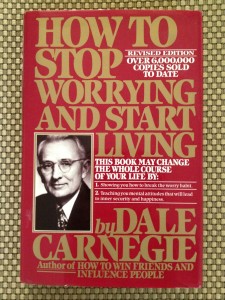
Before I was a young, arrogant SEIT at General Motors, I had never heard of Dale Carnegie or his fabled training. (To answer your question: SEIT stands for Salaried Employee In Training. Thus, my lifelong fascination with acronyms…)
I will never forget the day the narcoleptic designated as my boss stopped by my goldfish-bowl sliver of an office, tapped me on the shoulder, and said, “It’s your turn to take Dale Carnegie training.” Naturally, I provided the appropriate reply: “Oh, great–thank you.” But my Little Miss East Coast mind said to itself, “What the f#@k is Dale Carnegie training?!?”
I admit I was a blatant cynic regarding such training. All throughout the after-hours company class those 14 weeks, my attitude generated spectacular fireworks (aka head-butting) with the local Dale Carnegie franchise owner’s son, one of my instructors. I’ll leave that anecdote where it belongs–quarantined by my blog’s anti-spam plugin.
Since taking the Human Relations Principles class, I’ve had ample opportunity to discard those Dale Carnegie books gifted to me as part of my company-paid tuition. Oddly enough, I never did. I’m so grateful for my pack-rat tendencies regarding printed books…
As I age, Mr. Carnegie’s words become more meaningful (and less hokey) to me. There’s one specific Dale Carnegie book I find more comforting than the rest: How to Stop Worrying and Start Living.
Sounds great, but not so easy to accomplish. I say this as a (tempered) Type A who earned a tidy sum in college lending my course notes to other students who seemed much more prepared than I was to start living.
The entire book is eternally read-worthy. But there’s one thought, one snippet of advice I wrap my wandering mind around as often as possible. It’s…
“Live in ‘Day-Tight Compartments'” (Don’t Worry, There’s More…): Yep, that was the upfront reveal. I’m sharing it with you in the same spirit that Dale Carnegie shared in it the book; it’s the first chapter of Part One (“Fundamental Facts You Should Know About Worry”).
He attributes the original phrase, “…to live with day-tight compartments,” to Sir (and Doctor) William Osler. If you believe you understand these words and are fully equipped to start implementing them, stop reading RIGHT NOW and get to it.
I’m serious. If you get it, get going. But if you want some depth with your self-improvement fries, please, keep reading…
“Live in ‘Day-Tight Compartments'” by Planning Without Anxiety: Being focused on today’s tasks, and only today’s tasks, doesn’t mean you should abandon your planning instinct if you live to plan. Dale Carnegie evolved into a joyful man, but he was not was a careless human being.
Here’s Mr. Carnegie at his best:
“By all means take thought for the tomorrow, yes, careful thought and planning and preparation. But have no anxiety.”
See, Dale realized it wouldn’t be prudent to start or run a business without a plan. Just don’t work yourself into a self-paralyzing stupor about the plan’s next day–take care of TODAY’s piece of that plan.
“Live in ‘Day-Tight Compartments'” by Accepting That One Step Is Enough (For You): Another person who found his way into Chapter One of Dale Carnegie’s How to Stop Worrying and Start Living was Arthur (Hays) Sulzberger. From 1935 to 1961, he was the publisher of The New York Times.
The man who helped steer journalism’s rudder during World War II was so caged by his own future thoughts that he woke up most nights. He tried painting a self-portrait as a means of banishing his sleeplessness.
But endless nights of artistic effort didn’t bring restorative rest. It took these words from a John Henry Cardinal Newman church hymn (aka “Lead, Kindly Light”) for Sulzberger to steady himself and process each day’s tragic events without fear:
“…one step enough for me.”
Instead of letting all the days ahead figuratively glue you into a lifetime of worry, view each day as the one step you’ll take only on that day.
“Live in ‘Day-Tight Compartments'” by Treating Your To-Do List Like an Hourglass: Nothing enhances a lesson about circumventing worry like another Dale Carnegie anecdote.
In How to Stop Worrying and Start Living, he shares the story of an Army officer in Europe who worried himself into a state of serious physical and mental exhaustion toward the end of World War II.
Diagnosed with a psychosomatic disorder (spasmodic transverse colon), the officer received life-changing wisdom from the Army dispensary’s doctor in the form of an hourglass analogy:
“I want you to think of your life as an hourglass…Nothing you or I could do would make more than one grain of sand pass through this narrow neck without impairing the hourglass. You and I and everyone else are like this hourglass. When we start in the morning, there are hundreds of tasks which we feel that we must accomplish that day, but if we do not take them one at a time and let them pass through the day slowly and evenly, as do the grains of sand passing through the narrow neck of the hourglass, then we are bound to break our own physical or mental structure.”
In other words, handle what you can in any one day before turning your hourglass over the next day. And while you’re at it, stop multitasking. Just stop! I no longer include this word in my vocabulary…
“Live in ‘Day-Tight Compartments'” with Additional Help from Thomas Carlyle: In How to Stop Worrying, Dale Carnegie borrowed and built upon Sir William Osler’s compartmentalized advice. He also revealed the source of Sir William’s wisdom.
The man who helped found a sleepy little institution called Johns Hopkins University School of Medicine read one sentence that allegedly put him on a worry-free path for the rest of his life.
The sentence, written by 19th-century poet and author Thomas Carlyle, states:
“Our main business is not to see what lies dimly at a distance, but to do what lies clearly at hand.”
This opinion, combined with an in-person demonstration of an ocean liner’s watertight compartments, led to Sir William’s philosophy of living in “day-tight compartments.”
From this moment on, be willing to shut and lock the doors of your past mistakes and future fears. However, please don’t be tempted to associate Sir William’s analogy with the RMS Titanic…
Additional Quotes and Resources from Dale Carnegie’s How to Stop Worrying Book: Continue self-soothing your mind with more of Mr. Carnegie’s benevolent balm:
“So let’s be content to live the only time we can possibly can live: from now until bedtime.”
“Every day is a new life to a wise man.” (Mr. Carnegie tells the story of a discouraged woman who read this sentence in an article. She typed it onto a piece of paper and pasted it to her car’s windshield for daily viewing…)
Finally, here’s a poem (by Indian dramatist Kalidasa) Mr. Carnegie claimed he pasted to his own bathroom mirror: “Salutation to the Dawn.”
How do you feel right now at the dawn of your personal and professional 2016? When you first read the phrase “Live in ‘day-tight compartments,'” what visual immediately entered your mind?
Is fretfulness an everyday behavior for you? If so, are you now ready to “Let It Go” via Dale Carnegie’s seasoned (but still timely) advice?
I wish you all the best TODAY possible!
Lori Shapiro is the owner of By All Writes LLC, a business-to-business (B2B) company in Marlton, New Jersey, that plies its trade via copywriting, editing, and other content-development services. She revels in shielding her clients from the torturous, time-consuming pain of writing their own print or web marketing/promotional copy.
Please call Lori Shapiro of By All Writes LLC at 856-810-9764 (or e-mail her via lori@byallwrites.biz) to schedule a gratis 20-minute consultation that will propel you toward resolution of your current content dilemma…










Great post, Lori! We can all get overwhelmed by everything on the “to-do” list. I find that especially true at the beginning of a shiny new year. Thanks for the reminder to take it one day at a time. :O)
Thank you, Colleen.
I’ve been overwhelmed for months now with my son’s approaching Bar Mitzvah. This is probably why I entrusted my first blog post of 2016 to Mr. Carnegie’s evergreen advice.
Thanks again for chiming in–enjoy each “day-tight compartment” as it comes…
I enjoyed this post, Lori. I’m all for getting something good out of corporate-paid training. 😉 What I am most excited to learn, however, is that you worked for GM, as I worked for Ford – although they didn’t have any acronyms for “contract employee of another agency with less expensive benefits and no stock options, unless it might have been Supply Help In Technology. We did have an acronym for the database I worked on, known as the Corporate Technical Information System, or CTIS. The first time I ever googled myself, many many years ago, I came across a research paper which, if I recall correctly, was on how not to run a corporate library. CTIS – and our org chart at the time – was prominently featured. No one offered us any Dale Carnegie training, though. That might have helped.
Hi Paula,
Thanks for your patience re: my delayed reply. I am less than two months away from falling off my son’s Bar Mitzvah cliff; miles to go before I sleep…
So, you are also a survivor of the automotive industry (the most testosterone-filled “old boys’ club” I ever experienced). We’ll have to “talk shop” one day; Dearborn was always considered enemy territory by my superiors! I didn’t fully immerse myself into the acronym way of life until I transferred to Saturn.
I also didn’t value my Dale Carnegie training until much later in life, but I’m so glad I kept the books. If you’ve never read any of Mr. Carnegie’s tomes, I suggest starting with “How to Win Friends and Influence People.” It’s never too late to learn…
See you on the Twinternet, Paula.
Regards,
Lori